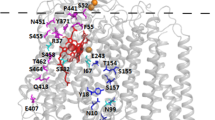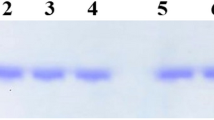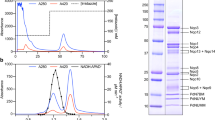Abstract
Phenylalanine 87 of yeast iso-1-cytochromc c (Phe 82 in horse heart and bonito) is phylogenetically conserved1 and occurs near the surface of the protein2. It has been suggested that this residue is directly involved in electron transfer between cytochrome c and cytochrome c peroxidase (CCP)3 and may also control the polarity of the haem environment4. Because Phe residues are not susceptible to chemical modification, no direct means of studying the functional role of Phe 87 has been available, so we have chosen Phe 87 as our initial target here to test the feasibility of using site-directed mutagenesis5 as a means of studying structure–function relationships in cytochrome c. We have changed the codon for Phe 87 to that of either a Ser, a Tyr or a Gly. The mutated genes have been introduced6 into a yeast strain7 lacking both isozymes of cytochrome c. Unlike the recipient strain, transformants grow on a non-fermentable carbon source, indicating that the mutant proteins can reduce cytochrome oxidase7. The purified mutant proteins are similar to wild type with respect to their visible spectra8, 20–70% as active as wild-type protein in the CCP assay9, and their reduction potentials are lowered by as much as 50 mV. Thus Phe 87 is not essential for cytochrome c to transfer electrons but is involved in determining the reduction potential.
This is a preview of subscription content, access via your institution
Access options
Subscribe to this journal
Receive 51 print issues and online access
$199.00 per year
only $3.90 per issue
Buy this article
- Purchase on Springer Link
- Instant access to full article PDF
Prices may be subject to local taxes which are calculated during checkout
Similar content being viewed by others
References
Dickerson, R. E. & Timkovich, R. Enzymes 11, 397–547 (1975).
Takano, T. & Dickerson, R. E. J. molec. Biol. 153, 79–94 (1981).
Poulos, T. L. & Kraut, J. J. biol. Chem. 255, 10322–10330 (1980).
Kassner, R. J. Proc. natn. Acad. Sci. U.S.A. 69, 2263–2267 (1972).
Zoller, M. J. & Smith, M. Meth. Enzym. 100, 468–500 (1983).
Hicks, J. B., Strathern, J. N., Klar, A. J. S. & Dellaporta, S. L. in Genetic Engineering: Principles and Methods Vol. 4 (eds Setlow, J. K. & Hollaender, A.) 219–248 (Plenum, New York, 1982).
Faye, G., Leung, D. W., Tatchell, K., Hall, B. D. & Smith, M. Proc. natn. Acad. Sci. U.S.A. 78, 2258–2262 (1981).
Margoliash, E. & Frohwirt, N. Biochem. J. 71, 570–572 (1959).
Kang, C. H., Ferguson-Miller, S. & Margoliash, E. J. biol. Chem. 252, 919–926 (1977).
Montgomery, D. L., Hall, B. D., Gillam, S. & Smith, M. Cell 14, 673–680 (1978).
Smith, M. et al. Cell 16, 753–761 (1979).
Lederer, F., Simon, A. M. & Verdiere, J. Biochem. biophys. Res. Commun. 47, 55–58 (1972).
Messing, J. Meth. Enzym. 101, 20–78 (1983).
Norris, K., Norris, F., Christiansen, L. & Fill, N. Nucleic Acids Res. 11, 5103–5112 (1983).
Astell, C. R., Doel, M. T., Jahnke, P. A. & Smith, M. Biochemistry 12, 5068–5074 (1973).
Gillam, S., Waterman, K. & Smith, M. Nucleic Acids Res. 2, 625–634 (1975).
Woo, S. L. C. Meth. Enzym. 68, 389–395 (1979).
Sanger, F., Nicklen, S. & Coulson, A. R. Proc. natn. Acad. Sci. U.S.A. 74, 5463–5467 (1977).
Sanger, F., Coulson, A. R., Barrell, B. G., Smith, A. J. H. & Roe, B. A. J. molec. Biol. 143, 161–178 (1980).
Hanahan, D. J. molec. Biol. 166, 557–580 (1983).
Ito, H., Fukuda, Y., Murata, K. & Kimura, A. J. Bact. 153, 163–168 (1983).
Sherman, F. et al. J. biol. Chem. 243, 5446–5456 (1968).
Nelson, C. E., Sitzman, E. V., Kang, C. H. & Margoliash, E. Analyt. Biochem. 83, 622–631 (1977).
Reid, L. S., Taniguchi, V. T., Gray, H .B. & Mauk, A. G. J. Am. chem. Soc. 104, 7516–7519 (1982).
Delange, R. J., Glazer, A. N. & Smith, E. L. J. biol. Chem. 245, 3325–3327 (1970).
Adams, S. P., Kavka, K. S., Wykes, E. J., Holder, S. B. & Galluppi, G. R. J. Am. chem. Soc. 105, 661–663 (1983).
Atkinson, T. & Smith, M. in Oligonucleotide Synthesis: A Practical Approach (ed. Gait, M.) (IRL, Washington DC, in the press).
Author information
Authors and Affiliations
Rights and permissions
About this article
Cite this article
Pielak, G., Mauk, A. & Smith, M. Site-directed mutagenesis of cytochrome c shows that an invariant Phe is not essential for function. Nature 313, 152–154 (1985). https://doi.org/10.1038/313152a0
Received:
Accepted:
Issue Date:
DOI: https://doi.org/10.1038/313152a0
This article is cited by
-
Stability of uniformly labeled (13C and 15N) cytochrome c and its L94G mutant
Scientific Reports (2021)
-
The role of key residues in structure, function, and stability of cytochrome-c
Cellular and Molecular Life Sciences (2014)
-
Enhanced stability in vivo of a thermodynamically stable mutant form of yeast iso-1-cytochrome c
Molecular and General Genetics MGG (1995)
-
The value of chemical shift parameters in the description of protein solution structures
Journal of Biomolecular NMR (1991)
Comments
By submitting a comment you agree to abide by our Terms and Community Guidelines. If you find something abusive or that does not comply with our terms or guidelines please flag it as inappropriate.



